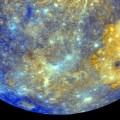
In this photograph of the sun taken by the Atmospheric Imaging Assembly on March 30, 2010, the color red shows emission from ionized helium at a temperature of 140,000 Fahrenheit, while green shows ionized iron at a temperature of 1,800,000 F. Credit: NASA.
NASA’s recently launched Solar Dynamics Observatory is returning early images that confirm an unprecedented new capability for scientists to better understand our sun’s dynamic processes. Some of the images from the spacecraft show never-before-seen detail of material streaming outward and away from sunspots. Others show extreme close-ups of activity on the sun’s surface. The spacecraft also has made the first high-resolution measurements of solar flares in a broad range of extreme ultraviolet wavelengths.
Launched on Feb. 11, 2010, the observatory is the most advanced spacecraft ever designed to study the sun. During its five-year mission, it will examine the sun’s magnetic field and also provide a better understanding of the role the sun plays in Earth’s atmospheric chemistry and climate.
The observatory carries three state-of the-art instruments for conducting solar research: the Atmospheric Imaging Assembly, the Extreme Ultraviolet Variability Experiment, and the Helioseismic and Magnetic Imager. These three instruments observe the sun simultaneously, performing the entire range of measurements necessary to understand solar variations. The Smithsonian Astrophysical Observatory is a major partner in the Atmospheric Imaging Assembly, which is a group of four telescopes that photograph the sun in 10 different wavelength bands, or colors, once every 10 seconds. Its images will help astronomers link changes in the sun’s surface to interior changes. The Smithsonian Astrophysical Observatory built the four telescope assemblies and participates as a full partner in the scientific analysis activities.
This movie of the March 30, 2010 prominence eruption of the sun, starting with a zoomed in view, was taken by the new Solar Dynamics Observatory. (Video courtesy NASA)
“Everything about the AIA images is cleaner and better than anything we’ve had before. The mirrors are better, the cameras are better and the amount of data available is better. It all combines to give us a view of the corona that we’ve never had before,” said Smithsonian astrophysicist Leon Golub, a co-investigator on the Atmospheric Imaging Assembly.
SDO is the first mission of NASA’s Living with a Star Program, or LWS, and the crown jewel in a fleet of NASA missions that study our sun and space environment. The goal of LWS is to develop the scientific understanding necessary to address those aspects of the connected sun-Earth system that directly affect our lives and society.





